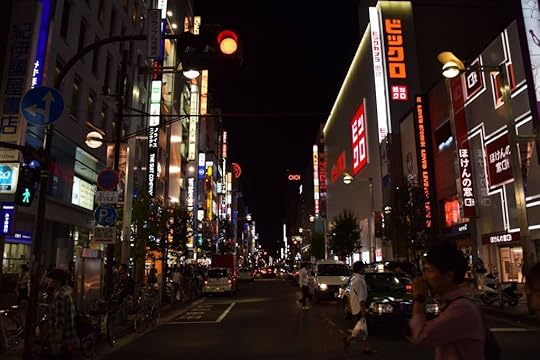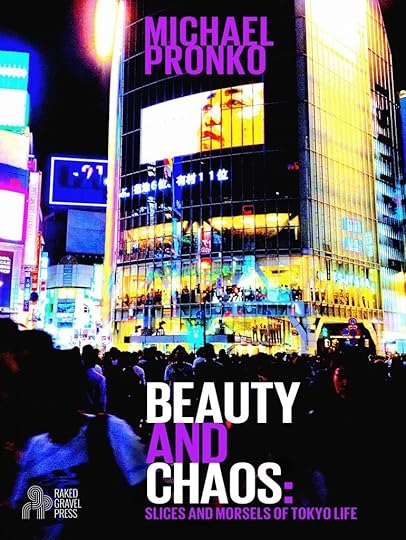Michael Pronko's Blog, page 24
October 18, 2014
Essay on Essays
October 19, 2014
Essays should probe, question and clarify; they do not have to finalize, conclude or prove. They should open up dialogue; they do not pass judgments. They might transform beliefs, but mostly they are about seeing the extraordinary in the ordinary.
The pattern of essays, like Tokyo’s patterns, can juggle quick shifts in style, tone and abstraction. The short essay best corrals my experience of Tokyo, all the feeling, seeing, sorting, and ruminating.
Tokyoites are amazingly good at switching modes, from a small focus to a huge one, from close attention to total indifference, from anonymity to intimacy. Essays fit Tokyo well for just that reason. They can do much the same.
I feel inspired by the constant surprise of the city, and surprise creates its own style and tone and form. These essays are both an embrace and a pushing back against a city I find alluring and vital, tough and bewildering.
Observing, asking, stopping in, wondering, and questioning became part of how I live here, a defense and recuperation, but an interaction and reception, too. I live here now. There’s weird stuff every day.
Much of Tokyo seems practical, efficient and shiny-clean. But Tokyo is also as complex as a long novel, as confusing as an avant-garde film and, as soberly, singularly beautiful as a character of calligraphy on a pure white background.
Tokyo is a triathlon of a city. But, taking time to uncover the hidden meanings and obscure values gets past the surface. People are running all the time in Tokyo, but they are running for reasons.
Tokyo’s meanings appear only in scattered observations, odd experiences, and disparate fragments of life. Tokyo is a city that resists generalization, in a very willful and quirky way. Tokyo is a capricious city.
Like a traditional Japanese garden, wherever you look it seems to be a different place altogether. Moments of alienation are followed by moments of exhilaration; aggravations turn to amusements; confusions tumble into insights. You just have to step to a different point of view and look again. These essays step aside, back, and forward, to find new points of view.
I love wandering the city, but if I go looking for an essay topic, I never find one. I get hit by topics in the normal course of the day. Observing, asking, stopping in, wondering, and questioning have become part of how I lived here. I live here now. There’s weird stuff every day.
Why Tokyo?
October 18, 2014
Tokyo is a place full of hidden meanings and provocative experiences. It’s a city whose hugeness refuses simple metaphors and passing conclusions. Tokyo is an imaginary construct, and does not really exist in any single place or in any exact way.
From the bonenkai museum, to standing bars, to awesome ancient temples, bizarre architecture and hordes of commuting, consuming humans, Tokyo’s supply of meaning-rich streams are inexhaustible.
Tokyo presses up close and swallows perspective, stretching over huge swaths of territory, both literal and figurative. It resists interconnection, conclusion, conviction. To live here is to always feel
In Tokyo, one’s gaze is always focused ahead on a single point, with passing details hard to grasp, but pressing in unconsciously. Much of Tokyo life takes place in spaces hidden away, situations too subtle to grasp, and in small details never explained.
Tokyo slips through words like water through a net. To use the Buddhist metaphor, writing about Tokyo’s meanings is like catching fish with a hollow gourd. The most clearly worded meanings slip soonest back into the watery immensity of the city.
Tokyo offers no easy foundation on which to build a high-rise skyscraper of explanation. But I’m not writing historical argument, data-laden research or watertight theories, I’m writing answers to the myriad questions Tokyo asks me every day.
To argue whether Japan is more unique than other cities is less the point than finding the beguiling details and suggestive meanings of its cumulative charm. Because Tokyo is larger than many entire countries, it deserves time and effort and thought to pick through all it offers so insistently and intensely.
Tokyo is not much written about in proportion to its immensity and complexity. Maybe Tokyo’s dispersed areas, obscure history, inconsistent design and incongruous elements resist analysis. But that’s just all the more reason to write about it. Tokyo pleads and struts to be noticed, but retires quickly, shyly, behind its many screens.
October 7, 2014
Beauty and Chaos
Whether contemplating Tokyo’s odd-shaped bonsai houses, endless walls of bottles, pachinko parlors, chopstick ballet or the perilous habit of running for trains, the essays in Beauty and Chaos explore Tokyo from the inside to reveal its deeper meanings and show why Tokyo is the most amazing, confusing city in the world.
Starting with observations and ending with insights, these essays dig into the ever-present but overlooked slices and morsels of daily life in the world’s biggest city. In turns comic, philosophic, descriptive and exasperated, the essays in this collection won acclaim in Japan from Tokyo readers.
Beneath Tokyo’s perplexing exterior, there’s meaning to the frantic swirl. By untangling the contradictions of the city and opening inner connections, Tokyo emerges a fascinating place of chaotic commotion, but serene, human-scale beauty, too.
If you’re traveling to Tokyo, these essays open up the sense and significance of life in this fast-paced, high-rise megalopolis. If you’ve ever considered going to Tokyo, these essays will give you more reasons to go, and ways to consider the city when you’re there.
Originally published in Japanese, these essays are available in English for the first time. Part travelogue, part comparative culture, and all creative essay, Beauty and Chaos taps the mystery of Tokyo and lets the meanings flow.
Buy on Amazon.com
Buy Kindle version
from Amazon Japan
September 15, 2014
The Last Train
Twenty million people a day ride Tokyo trains. Thousands of high-speed trains shoot by open platforms jammed with masses of commuters just a step–or a push–away. Under these conditions, disguising homicide as suicide is easy, Detective Takamatsu tells novice detective Hiroshi Shimizu. For one hostess working in the nighttime world of Tokyo’s entertainment clubs, the trains offer an easy way to conclude business relations, and extract revenge. From the sleek hostess clubs of Roppongi to sacred temples, from hidden yakuza headquarters to post-industrial wastelands, Tokyo is a city of exotic and deadly forces.







